Choosing the Easiest Wetsuit for Kiteboarding
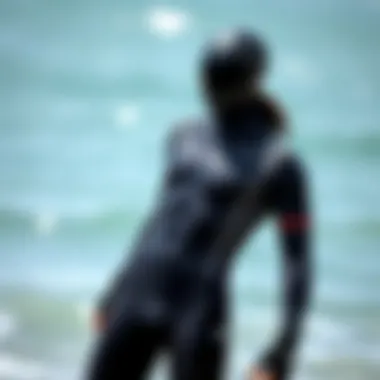
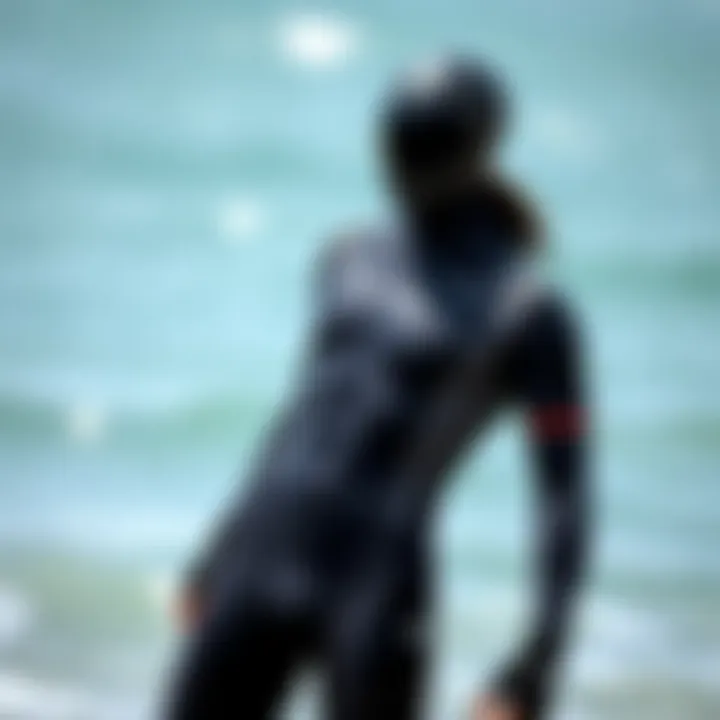
Intro
Alright, let’s dive into the often-overlooked world of wetsuits and how they play a vital role in kiteboarding. For many kiteboarders, the simple act of getting into and out of a wetsuit can be a real pain point. With the wind in your hair and the waves calling your name, the last thing you want is to wrestle with a suit that’s stiff as a board. That's why understanding the ins and outs of wetsuits becomes essential, not just for comfort, but for maximizing your time on the water.
Wetsuits come in various designs, materials, and closure systems, all of which can significantly affect how easily you can gear up or down. When it comes to kiteboarding, every second counts. If your wetsuit is a hassle, it can mean less time enjoying the ocean and more time struggling on the beach.
So, what do we mean by ease of donning and doffing? It’s quite simple but critical. Donning refers to putting on the wetsuit, while doffing is the act of taking it off. Both processes can range from “a piece of cake” to “what have I gotten myself into?” depending on the suit’s design. This guide aims to break down these nuances and help you make informed choices when selecting your next wetsuit, allowing you to focus more on riding the waves and less on gear-related woes.
Let’s get into the nitty-gritty.
Equipment Insights
Choosing the right wetsuit does not solely hinge on personal preference; it involves understanding features that facilitate easier use. Let’s explore the critical aspects that matter most.
Latest Gear Reviews
With the surge in popularity of kiteboarding, many brands have stepped up their game in terms of wetsuit design. Some key features to look for include:
- Material: Neoprene is the go-to material for wetsuits, but not all neoprene is created equal. Thickness plays a role as well—thinner options may offer ease of movement, while thicker ones provide better insulation.
- Design Features: Look for suits with a smooth skin exterior, which can help reduce water entry. Suits like the O'Neill Psycho Tech are often praised for their ease of entry due to features like side zippers and strategic seam placements.
- Closure Systems: Consider wetsuits with front-entry zippers. Many find these styles significantly easier to manage than back-zip models. Brands like Xcel have made strides in this area, incorporating innovative designs that speed up the process.
Wetsuit reviews online can be helpful. Websites like Reddit often share firsthand experiences from fellow kiteboarders, offering valuable insights into what works well in real-world scenarios.
Essential Gear Maintenance
Maintaining your wetsuit properly doesn’t just extend its lifespan; it can also enhance your overall experience. Even the best suits can become a chore to put on and take off if they’re not cared for properly. Here’s how to keep your gear in good shape:
- Rinsing: Always rinse your wetsuit in fresh water after a session. It helps remove salt and sand, which can cause damage over time.
- Drying: Dry it inside out, preferably away from direct sunlight. Hanging it properly will help retain its shape.
- Inspection: Regularly check for any signs of wear and tear, especially around the seams and zipper areas. A torn zipper can easily turn a simple release into a nightmare.
"A well-maintained wetsuit is like a trusted companion on the water. Treat it well, and it'll return the favor."
Arming yourself with knowledge about the right equipment and understanding how to maintain it can help eliminate unnecessary challenges—because at the end of the day, it’s all about the ride.
Closure
Understanding the nuances of wetsuit selection and upkeep makes all the difference in kiteboarding. When you can slip into your wetsuit effortlessly, you reclaim precious moments of freedom, joy, and adrenaline on the waves. Next time you're gearing up for a session, remember: the right choices today lead to brighter rides tomorrow.
Understanding Wetsuit Functionality
When diving into wetsuits, especially for kiteboarding, comprehending how they function holds paramount importance. A wetsuit isn’t just about looking good on the water, it plays a central role in your comfort and performance. The way a wetsuit is designed directly affects how quickly and easily you can put it on and take it off. Here, we'll unpack the essential components and attributes that define wetsuit functionality, shedding light on why these features matter for anyone riding the waves.
The Purpose of Wetsuits
Wetsuits serve a crucial purpose that goes beyond mere aesthetics. They act as a second skin, providing a layer of thermal insulation while also protecting the body from elements. There are various reasons why a wetsuit is indispensable for kiteboarders:
- Thermal Insulation: A well-fitting wetsuit traps a thin layer of water between the suit and the body, which warms up based on body heat, preventing loss of temperature. This is particularly vital during those chilly afternoon rides.
- Protection from the Elements: Many kitesurfers end up cruising across a variety of terrains, exposing them to rocks, jellyfish, or even harsh UV rays. Wetsuits provide a barrier against these elements, minimizing the risk of injuries or sunburn.
- Hydrodynamics and Buoyancy: The right wetsuit can enhance performance by providing buoyancy. A good fit means less drag in the water, allowing for smoother rides.
- Confidence and Freedom: When you know you’re protected from the cold and any potential hazards, you can focus on what really matters—enjoying the ride.
How Wetsuits Provide Insulation
The insulation that a wetsuit provides is not merely a matter of thickness. Various materials are used in wetsuit construction designed specifically for warmth and flexibility. Here’s how they keep you cozy:
- Neoprene Composition: Most wetsuits are made from neoprene, a synthetic rubber that naturally insulates. The thickness can vary; generally, thicker suits offer more insulation but can impede flexibility.
- Sealed Seams: The way seams are constructed plays a role in insulation. Sealed or taped seams can block water entry, which is crucial in maintaining warmth. If water can flow freely through the seams, it negates the insulation effect.
- Lining Materials: Some wetsuits have thermal linings made from materials like fleece or nylon, enhancing warmth without compromising flexibility.
- Fit Matters: Remember, the fit defines how well a wetsuit can insulate. A loose wetsuit allows excess water to circulate inside, defeating its purpose. A snug fit keeps that warm layer close to the body.
"Choosing a wetsuit with the right thickness and fit is key in ensuring that you stay warm and comfortable while riding, allowing you to focus on your performance and not on being cold."
Importance of Ease of Use
When it comes to kiteboarding, the last thing you want is to waste precious minutes struggling with your gear. The ease of use of a wetsuit can significantly impact your time on the water and overall kiteboarding experience. Wetsuits designed for simplicity ensure you can quickly put them on and take them off without a hitch. As the saying goes, "time is money," and in the world of kiteboarding, every minute counts.
Not only does a user-friendly wetsuit save you time, but it also plays a crucial role in safety and comfort. If you find yourself wrestling with a stiff suit, your focus shifts from riding the waves to just trying to get comfortable. This distraction can result in accidents, which is not what anyone wants when enjoying water sports. Flexible and easy-to-manage wetsuits enhance your ride by allowing you to concentrate solely on the adventure ahead.
Time Efficiency in Kiteboarding
In the competitive landscape of kiteboarding, efficiency is key. A wetsuit that’s quick to don and doff can be a game-changer, getting you into action faster. Think of it this way: every minute saved slipping in and out of your wetsuit is another minute to practice your tricks or enjoy the wind beneath your kite.
The best wetsuits often have features like sophisticated zipper systems or innovative entry techniques that reduce the hassle of getting dressed. For instance, some wetsuits use chest zips or back zips with user-friendly designs that minimize the fight against your own clothing.
- Quick zippers: Wetsuits with easy slide zippers significantly shorten the time spent putting on and taking off.
- Integrated pull loops: These handy features often speed up the process, allowing you to hook onto something secure and yank quickly.
Reducing Injury Risk
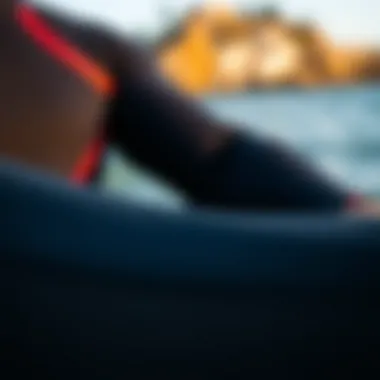
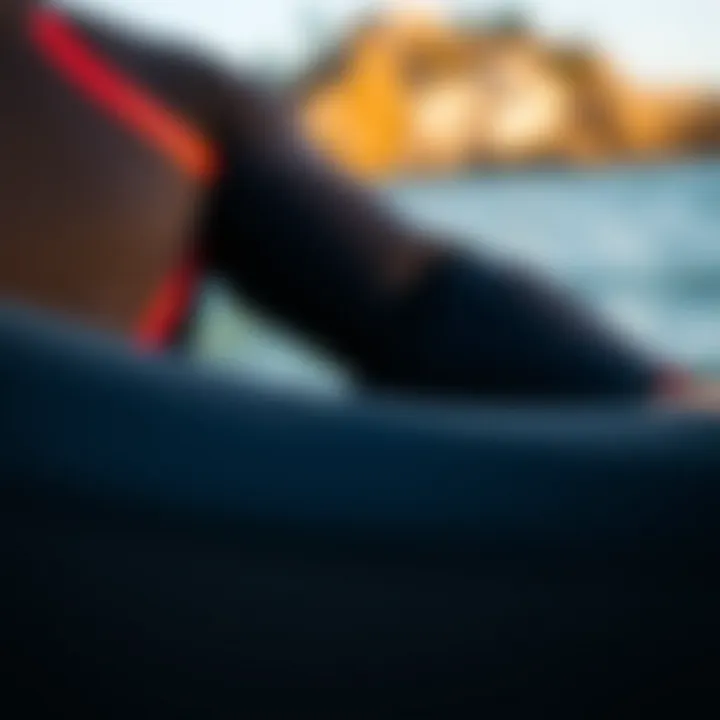
Wearing a wetsuit shouldn't feel like a wrestling match. An ill-fitting and cumbersome suit can lead to injuries, specifically when getting in and out of the water. A sleek, easy-to-manage wetsuit helps avoid strains and sprains, especially if you find yourself in a hurry.
Additionally, if you’re struggling to remove or adjust your wetsuit, you may be tempted to focus more on that instead of monitoring your surroundings. This lack of awareness could lead to accidents in the water or even on the shore. Comfortable and easy-to-use wetsuits can also help maintain body temperature, reducing the risk of hypothermia when you're out for long hours.
In summary, optimal ease of use in wetsuits is not just about convenience, but it also serves a larger purpose. It elevates safety, enhances overall performance, and ensures you make the most of your kiteboarding experience. Thus, it’s well worth investing time and effort to choose the right suit that aligns with your preferences.
Key Features that Enhance Accessibility
When selecting a wetsuit, ease of donning and doffing becomes paramount for kiteboarders who wish to spend minimal time fussing with their gear and more time enjoying the water. Several key features take center stage when it comes to making a wetsuit user-friendly. It's not just about the style or color; it's the functionality and how the suit interacts with your body.
Material Flexibility
Material plays a vital role in how easily a wetsuit goes on and off. Neoprene is the traditional choice, but not all neoprene is created equal. High-stretch versions allow for greater ease of movement and a snug yet comfortable fit. Such materials have the elasticity that feels like a second skin, permitting you to slip into or out of your wetsuit without a herculean effort.
Considerations when looking at material flexibility include:
- Thickness: Thinner neoprene is often easier to handle; however, ensure you get the right warmth for your chosen environment.
- Flexibility Ratings: Check for terms like "Superstretch" or "Ultra-flex"—these are often indications that the wetsuit will mold easily to your body, aiding accessibility.
- Layering: Some suits feature a double-layered construction that, while often warmer, can complicate the donning process. Balance needs with usability.
Seam Construction Techniques
Seams can be the make-or-break point for a wetsuit's usability. The way a suit is stitched together not only determines its durability but also its accessibility. Flatlock seams are common, but they may expose the seams to the water, thereby reducing warmth. Blind-stitched seams, on the other hand, can be more forgiving on the skin and often provide better waterproofing.
Some key attributes of seam construction include:
- Seam Types: Different seam methods, such as taped seams or glued seams, can enhance comfort while ensuring that the wetsuit retains its shape over time.
- Placement: A well-thought-out seam placement can prevent chafing or pinching, making it easier for the user to slide in and out.
- Elasticity: Flexible seams allow for more natural movements, critically affecting usability during entry and exit.
Choice of Zippers
Never underestimate the power of the zipper on a wetsuit. It should aid convenience but also contribute to water integrity. Rear zippers are popular but can sometimes be less accessible, requiring a little gymnastics to manage. Front zippers or side zippers can often provide an easier chance to enter with minimal fuss.
When contemplating zipper options, some factors to think about include:
- Quality: Heavy-duty, corrosion-resistant zippers can ensure longevity and aid ease of use, whether dealing with salt water or chlorinated water.
- Zipper Length: A longer zipper generally means easier access, but it could compromise the suit's warmth if not properly designed.
- Zipper System: Designs like quick-release zippers or those with pull tabs can make a world of difference when you're in a hurry.
"Choosing a wetsuit isn't just about looking stylish; it's about finding the right mix of features that make life easier when you hit the water."
Each of these features plays a significant part in the overall accessibility of wetsuits. Carrying out a thorough evaluation will benefit anyone who wants a smoother experience in the water, allowing them to focus on what truly matters: the thrill of riding the waves.
Popular Wetsuit Styles
When it comes to selecting a wetsuit for kiteboarding, the style you align with can significantly influence your experience on the water. Each type of wetsuit caters to different conditions and personal preferences, making it essential to understand the available styles and how they can ease the process of getting in and out of them. The right choice typically hinges on factors like water temperature, activity intensity, and individual comfort. Here’s a deeper look into the popular wetsuit styles, discussing their unique characteristics and advantages for users.
Full Suits
Full wetsuits, which cover you from head to toe, offer a robust layer of insulation ideal for colder waters. Their design incorporates long sleeves and legs, helping to retain body heat while you’re out riding the waves.
The major perk of a full suit, aside from warmth, is its coverage, which provides more protection against the elements, such as wind and sun exposure. For kiteboarders who often face cooler or unpredictable conditions, a full suit can be an absolute lifesaver.
However, getting into a full suit can sometimes call for a bit of hustle. The key is to look for one with an effective entry system, like a back zipper or front zip, that can make donning and doffing smoother. Also, keep an eye out for flexible material around the shoulders and knees to make those movements easier.
Shorty Suits
Shorty wetsuits offer a happy medium, leaving the arms, legs, and sometimes even feet exposed while ensuring that your core stays warm and comfortable in milder water temperatures. This makes it an attractive option for kiteboarders who often find themselves in warmer conditions yet still need some level of insulation.
One of the benefits of a shorty is the freedom of movement it provides. With fewer restrictions, you’ll find it less cumbersome to paddle out or maneuver your kite. Also, they are generally easier to pull on and take off, making them user-friendly for those quick trips to the water. Just be aware that while they might not be the best option for icy waters, they can work wonders during warmer summer days or when the sun is blazing.
Sleeveless Variants
Sleeveless wetsuits dive deeper into the realm of lightweight options, offering maximum freedom of movement while keeping the core warm. This style is perfect for kiteboarders who prefer a more unrestricted feel and are usually found in warmer waters or during summer sessions.
It’s common for these suits to have a higher stretchability, allowing for greater ease when you’re putting them on or taking them off. They provide a less restrictive fit through the arms and shoulder areas. However, since you sacrifice sleeve coverage, you might want to think about adding some sun protection with a rash guard on the hotter days.
In contemplating which wetsuit style suits your taste and needs best, always consider the specific conditions you’ll be facing as well as your personal comfort. The goal is to find a wetsuit that complements your kiteboarding experience while being easy to manage in terms of putting it on and taking it off.
Identifying User-Friendly Designs
When it comes to selecting a wetsuit that caters to the needs of kiteboarders, focusing on user-friendly designs is paramount. A wetsuit with a thoughtful design not only enhances your experience on the water but also saves you precious time and energy before hitting the waves. Convenience is king, especially when you're looking to maximize your time enjoying the sport you love. A user-friendly wetsuit aids in hassle-free donning and doffing, which is essential for those who are eager to jump in and out of the water frequently.
Key features in user-friendly designs can vary significantly from one wetsuit to another, and understanding what to look for can make all the difference. For kiteboarders, a wetsuit that allows for quick entry and exit, along with flexible materials, can prevent the frustration that often comes with traditional wetsuit designs. As we dive deeper into the topic, we'll break down specific elements that contribute to user-friendly designs and how they align perfectly with the demands of kiteboarding.
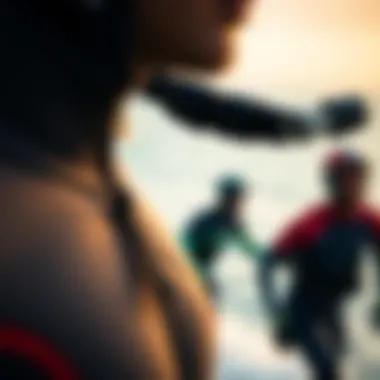
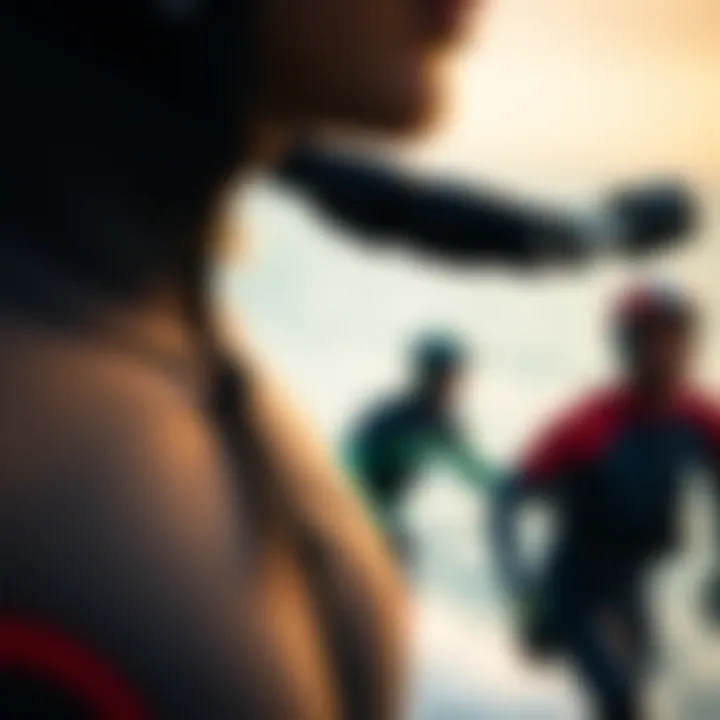
Easy Entry and Exit Systems
An easy entry and exit system is a defining feature of user-friendly wetsuits, especially for enthusiasts who value efficiency. Many modern wetsuits incorporate innovative closure mechanisms, such as front zips, back zips, or even zip-free designs, each boasting distinct advantages. A front-zip wetsuit, for instance, not only offers easier access, but also helps to prevent water from entering through the zip, keeping you warmer during your sessions. An alternative back-zip system is the go-to for those who prefer a more classic approach, yet this may come at a cost of accessibility depending on the suit’s construction.
Moreover, some wetsuits utilize unique Velcro or magnetic closures to facilitate swift movements. When the thrill of kiteboarding calls, the last thing you want is to wrestle with a stubborn zipper.
"Investing in a wetsuit with an efficient entry system can mean more time riding the waves and less time fumbling with your gear."
This aspect not only highlights ease of use but also emphasizes safety and comfort. A wetsuit that opens and closes swiftly allows users to jump in and out of the suit as conditions change or if they need to warm up during breaks. Whether you’re switching between different spots or simply enjoying the wind with your kite, these systems come in clutch.
Stretch Panels
Stretch panels are another essential feature that contribute significantly to the overall user experience. These panels are typically made from materials designed to stretch and conform to the body, providing ease of movement crucial for kiteboarding. A wetsuit with ample stretch allows riders to execute tricky maneuvers without being hindered by tightness.
The right stretch also improves comfort during long sessions, preventing chafing and discomfort, which can occur in less flexible suits. A common material found in such designs is neoprene, but advancements have introduced alternatives featuring recycled materials for the environmentally conscious kiteboarder. Some wetsuits even incorporate panels crafted from lightweight fabrics that dry quickly, ensuring that you don’t feel bogged down when stepping back into the water.
Moreover, a well-placed stretch panel can significantly improve fit and reduce water intake, enhancing thermal insulation—an often overlooked factor that can lead to much longer, enjoyable outings. A wetsuit that serves up both flexibility and comfort allows kiteboarders to fully immerse themselves in their activity, urging them to ride the waves like they’ve been doing it for ages.
Evaluating Fit and Comfort
When selecting a wetsuit, the fit and comfort are often the unsung heroes of your overall kiteboarding experience. It’s not just about grabbing the first flashy suit you see; you want your wetsuit to be a second skin, enhancing your movements while keeping you cozy against the elements. A well-fitted wetsuit ensures that you stay warm, minimizes water entry, and ultimately increases your performance.
Getting that perfect fit can elevate your time in the water from merely manageable to downright enjoyable. Here are a few elements to consider:
- Temperature Regulation: A snug fit helps trap warm water close to your body, maintaining an optimal body temperature. A suit that's too loose will allow water to flush in and out, leaving you cold.
- Mobility: If you can’t move freely, your performance will suffer. A good fit provides enough flexibility at the joints without sacrificing thermal protection.
- Stability: A well-fitted wetsuit stays in place while you kiteboard, granting you focus and confidence to tackle those waves without distraction.
In the following subsections, we will dive deeper into understanding how size guides and body shape considerations can assist you in finding that perfect fit.
Sizing Guides
Sizing guides are designed to steer you in the right direction, offering numerical values based on your measurements. Accurate sizing is the backbone of comfort and functionality. Most manufacturers provide size charts detailing the height, weight, and chest measurements needed to select the right wetsuit size. Don’t just guess; take the time to measure yourself.
Additionally, consider the following:
- Fit Types: Each brand may have a unique cut. Some might run smaller or larger, so familiarize yourself with the brand’s specific sizing.
- Try Before You Buy: Whenever possible, try the wetsuit on in-store or through a retailer with a good return policy. It’s the best way to gauge comfort levels.
- Feedback Forums: Check out discussions on platforms like Reddit or kiteboarding forums to see what others are saying about sizing. Users often share their experiences that can help others in navigating the choices.
Body Shape Considerations
Every body is unique, and so is your fit. It's crucial to factor in your body shape when selecting a wetsuit. A suit that fits one person might not work for you, even if you’re the same size on paper. Here are a couple of key points:
- Curvy Figures: If you have distinct curves, look for wetsuits that feature curved panels or tailored sections. These designs often provide better fit and comfort.
- Athletic Builds: For those with broader shoulders and a defined waist, consider suits specifically made for athletic builds. They allow for better movement without compromising thermal insulation.
- Shorter Stature: Brands often have alternative sizes for shorter individuals. Check for short-size wetsuits that cater to those with different proportions.
"In kiteboarding, as in life, comfort leads to confidence. Choose wisely."
For further details and guides on wetsuit sizing, visit resources like Wikipedia or check various discussions on Reddit.
An informed choice is like paddling with the wind at your back; it makes all the difference.
Brand Comparisons
When it comes to selecting the right wetsuit for kiteboarding, making informed choices about brands can significantly impact your experience on the water. Not all wetsuits are created equal; the nuances in design, material quality, and fit can vary greatly from one manufacturer to another. Therefore, understanding the landscape of wetsuit brands is essential for kiteboarders looking to optimize their performance and comfort when out tackling windy conditions.
These comparisons provide you with a framework to weigh the pros and cons, ensuring you land a wetsuit that fits snugly yet allows for freedom of movement. It’s also vital to consider your individual needs, some might prioritize warmth for the colder months while others might lean towards flexibility for those summer sessions. Here are some factors that one should keep in mind when comparing different brands:
- Material Specifications: Different brands utilize various types of neoprene and lining materials, which affect both warmth and flexibility. Some companies even chip in eco-friendly options, promoting sustainability.
- Stitching and Seam Construction: Quality of stitching can influence durability and resistance to water entry. Brands with blind stitching or liquid tape seams tend to perform better in preventing leaks.
- Zipper Design: Entry points play a crucial role. Some brands offer smooth back zippers for ease, while others might have front zip or no zip designs, which can affect how easy it becomes to put on or take off the wetsuit.
- User Reviews: The opinions of fellow riders can provide valuable insight into performance and longevity. Not all marketing hype correlates with real-world experiences; thus, personal testimonies and reviews become invaluable.
Gaining an understanding of these key elements creates a comprehensive perspective that aids in making the right choice among brands. It allows you to match your needs with features that resonate with your kiteboarding style.
Leading Wetsuit Manufacturers
Navigating through the plethora of wetsuit brands available can feel like trying to find a needle in a haystack. Here's a closer look at some of the more prominent names in the wetsuit industry that have made a mark for themselves:
- O'Neill: Known for their blend of high-performance suits with innovative technologies, O'Neill is a household name among water sport enthusiasts. Their wetsuits are crafted to balance flexibility and warmth.
- Rip Curl: Specializing in cutting-edge designs, Rip Curl offers wetsuits that cater to a wide range of activities including kiteboarding. They often integrate thermal panels to enhance insulation.
- Xcel: With a strong reputation for producing reliable products, Xcel wetsuits are often praised for comfort and warmth. Their emphasis on eco-friendly materials is also a draw for environmentally-conscious consumers.
- Mystic: This brand has cultivated an image of providing high-quality gear that does not compromise on style. Their innovative entry systems are usually highlighted in discussions around convenience.
By comparing these manufacturers based on the aspects mentioned earlier, you can zone in on a model that fits your needs like a glove.
Product Reviews and Ratings
Once you've narrowed down leading brands, the next step is delving into product reviews and ratings. They serve as an excellent resource for gauging how well a wetsuit performs in real-world conditions. Pay attention to:
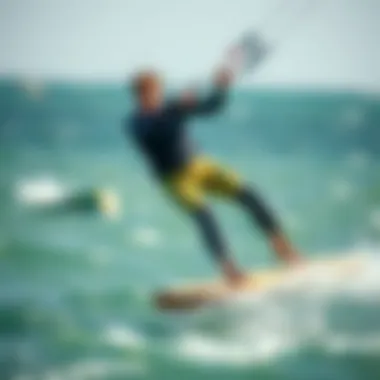
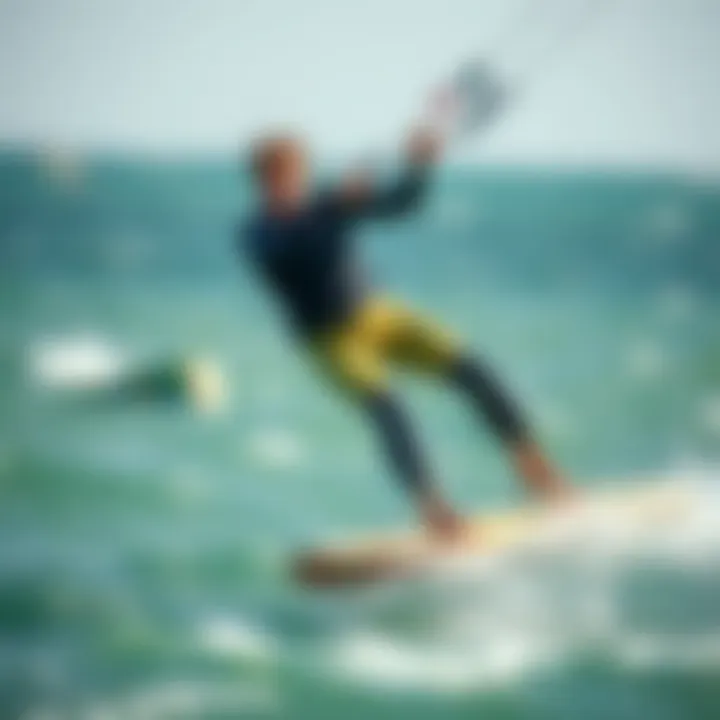
- Durability: Users often share their experiences with how a wetsuit holds up after multiple uses and washes. This insight can make a big difference, especially during intensive kiteboarding sessions.
- Fit and Comfort: Reviews frequently speak to sizing accuracy and overall comfort. Given that a wetsuit's fit dramatically impacts performance, personal accounts can help highlight brands that truly cater to diversity in body shapes.
- Ease of Donning and Doffing: Testimonials related to how easy or challenging it is to put on and take off a garment can guide potential buyers to more user-friendly options.
- Warmth and Insulation: Many reviews will discuss the suit's effectiveness in various water temperatures, helping you determine if it’s right for the conditions you’ll be using it in.
Let’s not overlook user-generated content from platforms like Reddit or kiteboarding forums, where experienced riders share their insights. Sometimes, a simple comment can shed light on an important detail you hadn’t considered.
User Experiences and Testimonials
Understanding how different wetsuits work for various individuals is crucial for kiteboarders. Personal experiences and testimonials provide insights that cannot be gleaned from product descriptions alone. They offer a window into real-life usability, fitting quirks, and specific advantages or disadvantages that may not be apparent when simply analyzing features on paper.
Feedback on User-Friendly Designs
The feedback surrounding user-friendly designs highlights how well certain wetsuit models cater to the needs of kiteboarders. Many enthusiasts report that suits with innovative zipper placements or stretchy materials make the dressing process a breeze.
For instance, some users appreciate wetsuits that feature front zippers, as these can reduce the struggle while putting the suit on. "With the front zip, it’s like slipping into a comfy jacket rather than wrestling into a skin-tight sleeve," one rider commented.
Furthermore, testimonials often reveal how smart seam placements contribute to overall ease of use. Wetsuits designed with fewer seams or reinforced joints not only enhance flexibility but also eliminate discomfort during donning and doffing. When users note that a particular wetsuit is both warm and easy to step in and out of, it's a clear cue that the manufacturer has prioritized functionality.
Comparative Ease of Use
Comparing various wetsuit models through user experiences sheds light on the overall ease of use. Experienced kiteboarders often share both joy and frustration regarding different brands. Many owners of Zealot Wetsuits report minimal difficulty when changing in and out of their suits, attributing this ease to the flexible neoprene combined with a user-friendly zipper system.
On the other hand, when juxtaposed with alternatives like Marine Gear Wetsuits, experiences reveal a stark contrast. Users have mentioned the cumbersome nature of certain older models, making them feel trapped rather than ready for action. The common sentiment? Ease of access matters significantly, especially when the sun’s beating down, and every second counts before hitting the water.
"Finding a wetsuit that is easy to take off after a long kiteboarding session is essential; I've often sacrificed comfort for performance until I discovered the right design for me," shared a frequent competitor.
Through these shared stories, individuals looking for their ideal wetsuit get a clearer picture of what works and what doesn’t. The tangible exchange of information underscores the importance of not merely relying on brands but rather engaging with fellow kiteboarders' experiences to find a wetsuit that promises both performance and ease in putting it on and taking it off.
Maintenance and Care for Longevity
Wetsuits are not just basic pieces of gear; they are your protective shield against cold water and harsh elements while out kiteboarding. Thus, proper maintenance and care play a crucial role in extending the lifespan and functionality of your wetsuit. Neglecting this aspect can lead to wear and tear, compromising both comfort and performance on the water.
For kiteboarders, a reliable wetsuit means not only a better experience but also safety. A well-maintained wetsuit retains its insulating properties and flexibility, allowing you to move freely and confidently. Regular cleaning, proper storage, and mindful handling can significantly impact how long your wetsuit serves you. It’s about making a simple investment of time for long-term benefits.
Cleaning Practices
Keeping your wetsuit clean is paramount. Salt water, sand, and sun exposure can degrade the materials over time. After each session, a few straightforward practices can make all the differences:
- Rinse Thoroughly: After using your wetsuit, rinse it in fresh water. This helps remove salt, sand, and any chemicals from pools or hot tubs that may dull the material.
- Gentle Wash: If necessary, a gentle wash with a wetsuit-specific cleaner or mild detergent can help keep it fresh. Avoid bleach, fabric softeners, or anything harsh that might damage the neoprene.
- Air Dry: Always hang your wetsuit upside down to dry in a shaded area. Direct sunlight can cause fading and weaken the fabric, affecting its elasticity over time.
By making these steps part of your routine, you ensure that your wetsuit retains its warmth and flexibility, keeping you comfortable while you ride the waves.
Storage Recommendations
Where and how you store your wetsuit also greatly influences its longevity. Think of your wetsuit as an investment; how you protect it matters:
- Avoid Folding: Never fold or crumple your wetsuit for storage. Instead, hang it on a wide shoulder hanger. This prevents creasing and helps maintain its shape.
- Cool, Dark Place: Store your wetsuit in a cool, dry, and dark spot. Humidity can lead to mold and mildew, while heat can warp the material.
- Inspect Regularly: While in storage, check for any signs of wear or damage. Early detection can save you from unexpected issues when you first hit the water next season.
By following these storage tips, you’ll keep your wetsuit in excellent condition, making sure it’s ready to perform when you need it most.
"A little care goes a long way. With just a bit of attention, your wetsuit can last for many seasons, ensuring that you enjoy every thrilling ride without the worry of unexpected mishaps."
By focusing on thorough cleaning practices and proper storage strategies, you can significantly enhance the durability of your wetsuit. This not only protects your investment but also ensures optimal performance every time you step into the water.
Sustainability in Wetsuit Manufacturing
In recent years, the conversation around sustainability has permeated various industries, and the wetsuit market is no exception. For kiteboarders, who spend a good chunk of time engaged with nature, understanding the sustainability of the gear they use is crucial. The significance of sustainability in wetsuit manufacturing extends beyond mere environmental trends—it touches on the heart of responsible oceanic sports. Selecting eco-friendly wetsuits not only reduces ecological harm, but it also sets a precedent for manufacturers to prioritize sustainable practices in their production lines.
Wetsuits traditionally made from neoprene, a petroleum-based product, are not the most environmentally friendly option. This leads to a growing demand for alternatives that minimize environmental impact. The brands that are leaning toward sustainable manufacturing practices offer a dual benefit: they provide high-performance products while also preserving the planet. Thus, when choosing a wetsuit, it’s vital for kiteboarders to consider the ecological implications of their gear.
Eco-Friendly Materials
The primary focus for sustainability in wetsuit manufacturing lies in the materials used. Many companies are now exploring innovative materials that either reduce reliance on toxic substances or utilize renewable resources. For instance:
- Yulex: Originating from sustainably harvested natural rubber, Yulex is becoming a preferred alternative to traditional neoprene. It maintains the same flexibility and insulation, but with a smaller carbon footprint.
- Bio-based Neoprene: Some brands have begun incorporating bio-based neoprene, which utilizes plant-based ingredients to replace a significant portion of the petroleum in traditional neoprene. While not entirely biodegradable, it's a step toward reducing fossil fuel use in wetsuit production.
- Recycled Materials: Another avenue being explored is the use of recycled plastics and rubber. Several wetsuit manufacturers are developing suits that incorporate recycled oyster shells, fishing nets, or even plastic bottles, merging modern technology with sustainable practices.
When kiteboarders choose wetsuits made from these alternative materials, they are actively participating in a movement toward greener practices within their sport. They choose performance without compromise to the health of the oceans.
Manufacturing Practices
How wetsuits are produced plays an equally important role in sustainability. It's not just the materials that matter, but the methods of production as well. Companies are adopting various practices that align with eco-conscious values:
- Low-Impact Manufacturing: Some manufacturers have optimized their production processes to reduce waste. From minimizing water usage in the production phases to employing less energy-intensive technologies, these practices lessen the overall environmental load.
- Certifications and Standards: Wetsuit brands that commit to sustainability often seek third-party certifications. For instance, the Global Organic Textile Standard (GOTS) certifies the organic status of textiles and helps consumers make informed decisions. Knowing whether a wetsuit meets these standards can significantly affect purchasing choices.
- Transparent Supply Chains: Many consumers today prefer brands that offer transparency regarding their supply chains. Understanding where and how materials are sourced can give kiteboarders confidence in their choice of wetsuit and its ethical impact.
By being aware of the sustainability factors in wetsuit manufacturing, kiteboarders can contribute to ocean conservation efforts while enjoying their sport. This dual consciousness empowers consumers and pushes manufacturers to become more environmentally accountable.
Considering sustainable practices in wetsuit manufacturing isn't just good for the ocean; it's good for the ethos of the sport itself. By making informed choices, kiteboarders can ride the waves with a heavy heart lifted by the knowledge that their gear reflects their respect for the environment.







